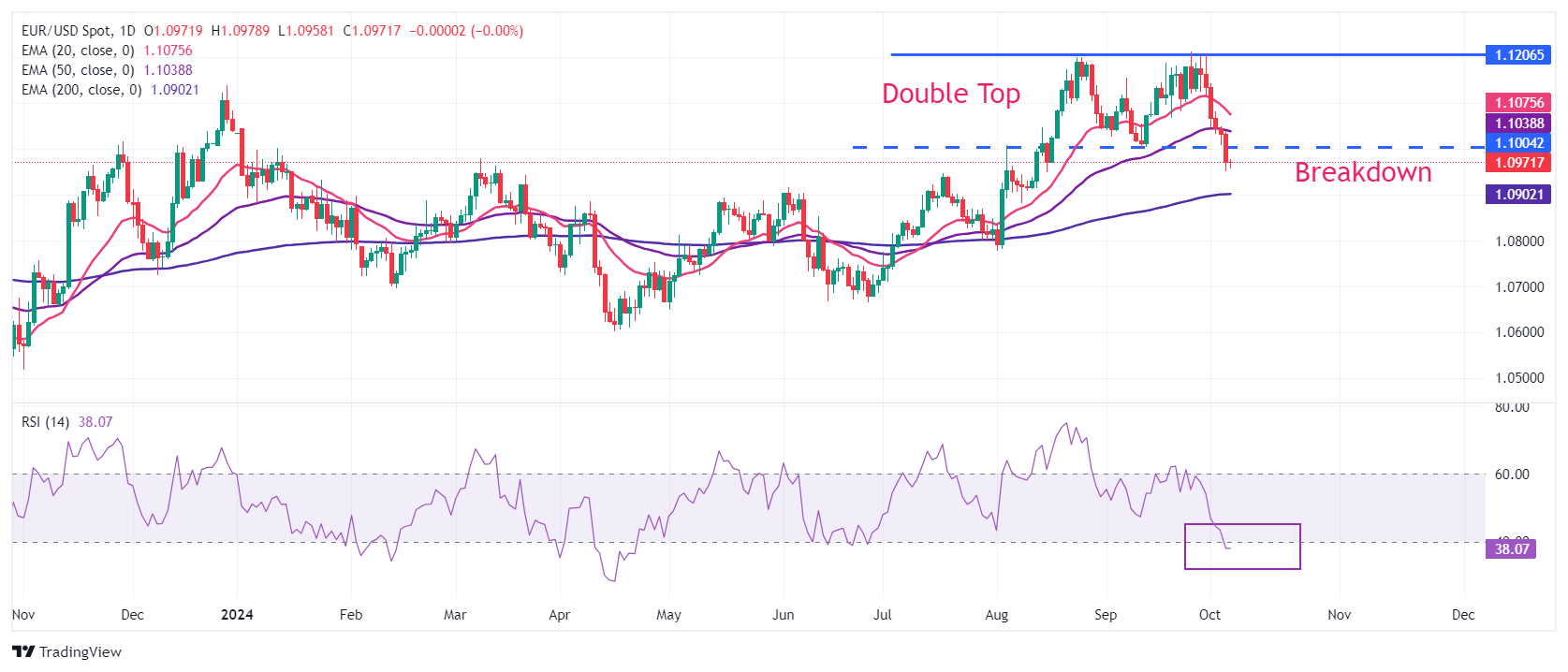- EUR/USD remains defensive near 1.0950 as the Fed is expected to follow a gradual rate cut approach.
- U.S. labor demand remained robust and wage growth increased in September.
- The ECB’s Villeroy supported another interest rate cut on October 17.
EUR/USD struggles to gain ground near the key support of 1.0950 in the North American session on Monday. The major currency pair remains on the defensive as the US Dollar (USD) holds on to gains near a new seven-week high, boosted by surprisingly upbeat United States (US) labor market data. for September published on Friday. The US Dollar Index (DXY), which measures the value of the Dollar against six major currencies, is trading near 102.50.
The US jobs report showed resilient labor demand and strong wage growth. According to the report, the economy added 254,000 nonfarm jobs, significantly higher than estimates of 140,000 and the previous release of 159,000, revised upward from 142,000. The unemployment rate slowed to 4.1% from expectations and August’s figure of 4.2%.
The upbeat jobs data forced traders to push back market expectations that the Federal Reserve (Fed) will cut interest rates by 50 basis points (bps) again in November. The Fed began its policy easing cycle with a larger-than-usual 50 bp rate cut in September.
Meanwhile, renewed fears that inflation will remain persistent following the release of higher-than-expected average hourly earnings for September also eliminated bets on a big Fed rate cut. Average hourly earnings, a key measure of wage growth, accelerated at a faster-than-expected pace to 4.0% year-on-year. The monthly wage growth measure rose 0.4%.
For more clarity on the outlook for interest rates, investors will focus on US Consumer Price Index (CPI) data for September, due out on Thursday.
Daily Market Summary: EUR/USD Struggles for Firm Base Amid Firm US Dollar
- EUR/USD remains vulnerable near 1.0950 in North American trading hours. In addition to the bullish US dollar, uncertainty over the outlook for the Euro (EUR) has also kept the pair on the back burner. The outlook for the Euro has become uncertain amid growing speculation that the European Central Bank (ECB) could cut interest rates again at its monetary policy meeting on October 17.
- The ECB’s big dovish bets for October have been driven by growing risks that inflation in the Eurozone could stabilize below the bank’s 2% target. The Eurozone’s annual Harmonized Index of Consumer Prices (HICP) slowed at a faster-than-expected pace to 1.8% in September, according to preliminary estimates.
- The economic outlook for Germany, the Eurozone’s largest economy, is weak due to low demand. The German economy is expected to have contracted by 0.2% annually for the current year, according to the ministry led by Robert Habeck of the Green party, the Sueddeutsche Zeitung newspaper reported on Sunday.
- Meanwhile, ECB policymaker and head of the French Central Bank, François Villeroy de Galhau, also emphasized the need to cut interest rates again this month, telling La Repubblica over the weekend. Villeroy said, “In the last two years, our main risk was exceeding our 2% target.” “We must now also pay attention to the opposite risk of missing our target due to weak growth and tight monetary policy for too long,” he added.
- On the economic data front, Eurozone retail sales rose but fell short of expectations in August. On an annual basis, retail sales rose 0.8% after contracting 0.1% in July. Economists expected retail sales to have grown 1%. On a monthly basis, retail sales rose as expected by 0.2%.
Technical Analysis: EUR/USD remains below the 20-day EMA
EUR/USD struggles for a firm base near the immediate support of 1.0950. The major currency pair is under widespread pressure as it has presented a downward break of the Double Top chart pattern on a daily time frame. The mentioned chart pattern was triggered after the currency pair broke below the September 11 low of 1.1000.
The 14-day Relative Strength Index (RSI) falls below 40.00. A bearish impulse would be triggered if the RSI remains below it.
Looking down, the pair is expected to find support near the 200-day EMA around 1.0900. To the upside, the 20-day EMA at 1.1075 and the September high around 1.1200 will be important resistance zones.
economic indicator
Non-farm payrolls
The most important result contained in the employment report is the monthly change in non-farm payrolls published by the US Department of Labor. The report publishes job creation estimates for the previous month and revisions to the data for the previous two months. Monthly changes in payrolls can be very volatile and the publication of this report generates high volatility in the dollar. A result above the market consensus is bullish for the dollar, while a result below expectations is bearish.
Last post:
Fri Oct 04, 2024 12:30
Frequency:
Monthly
Current:
254K
Dear:
140K
Previous:
142K
Fountain:
US Bureau of Labor Statistics
The monthly US employment report is considered the most important economic indicator for currency traders. Published on the first Friday following the reported month, the change in the number of employees is closely related to the overall performance of the economy and is monitored by policymakers. Full employment is one of the Federal Reserve’s mandates and it considers the evolution of the labor market when setting its policies, which affects currencies. Despite several leading indicators shaping estimates, Non-Farm Payrolls tend to surprise markets and trigger substantial volatility. Actual numbers that beat consensus tend to be bullish for the USD.
Source: Fx Street
I am Joshua Winder, a senior-level journalist and editor at World Stock Market. I specialize in covering news related to the stock market and economic trends. With more than 8 years of experience in this field, I have become an expert in financial reporting.








